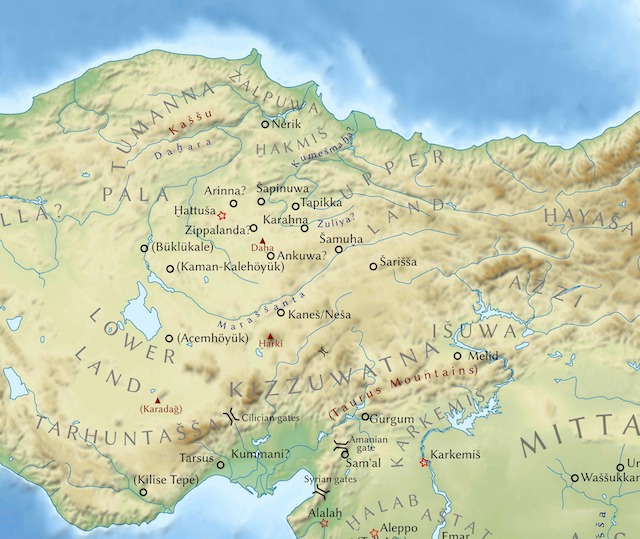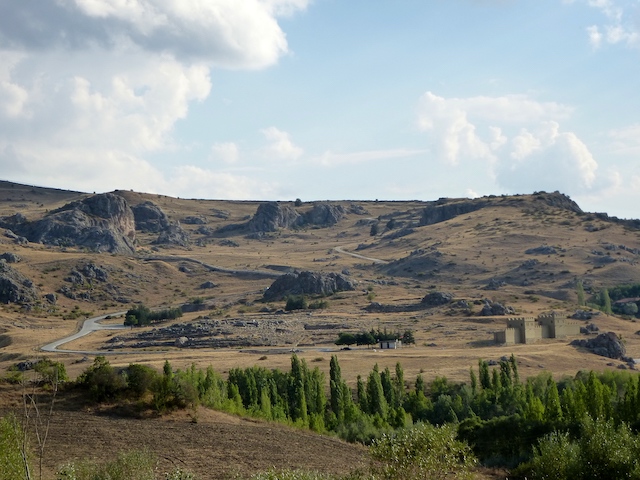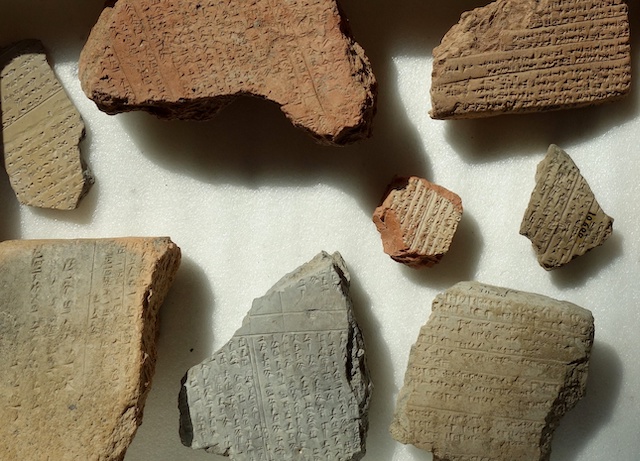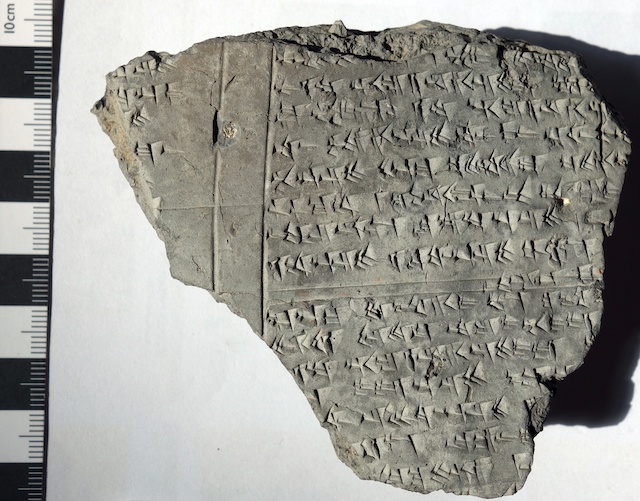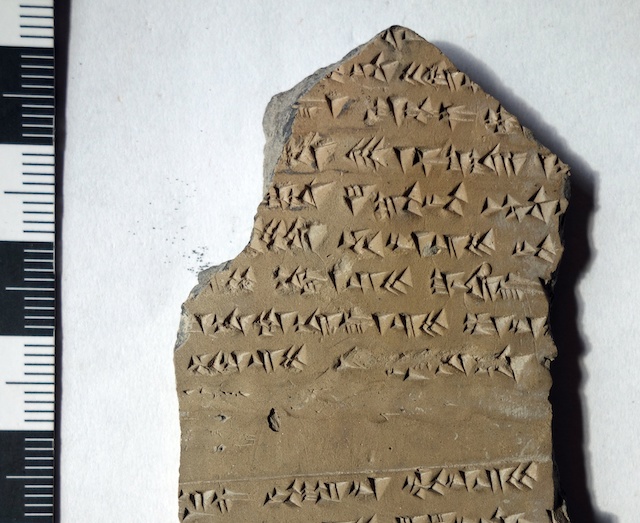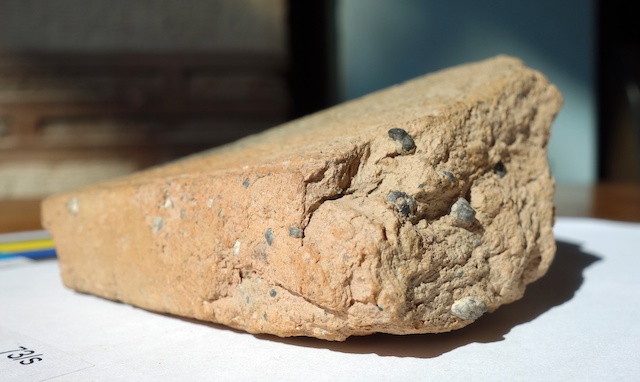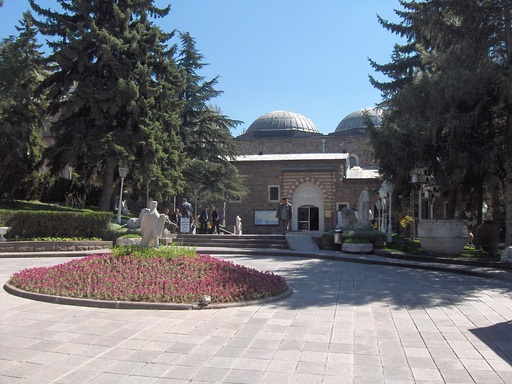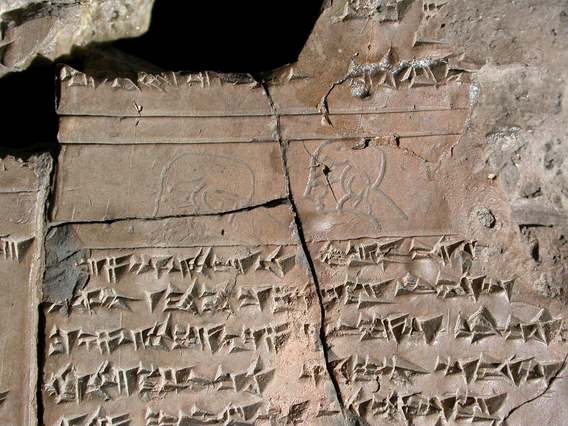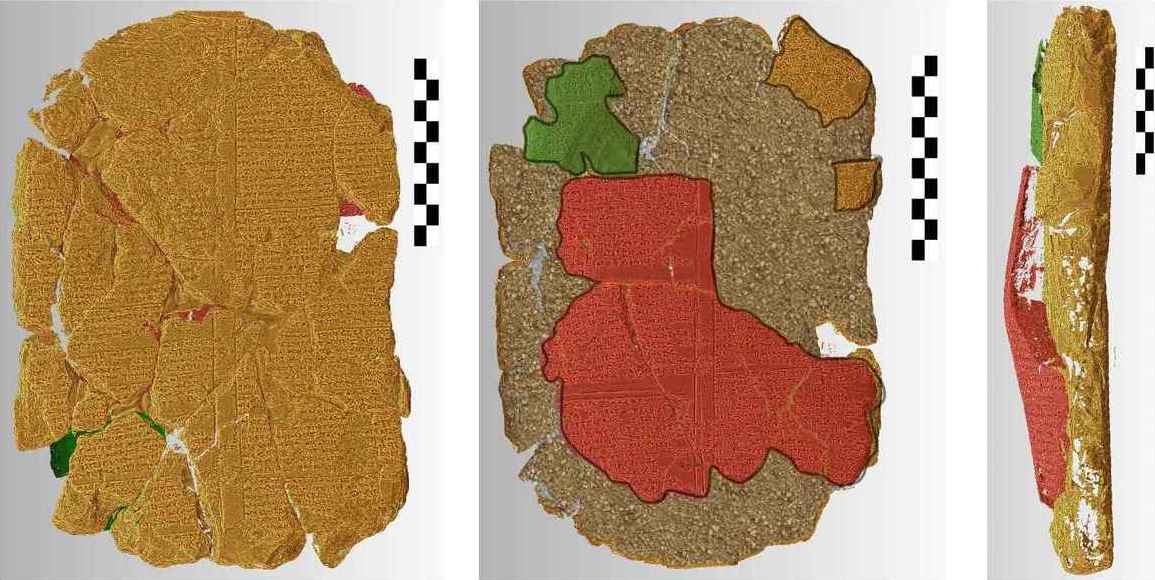Hittite Cult Inventories
Aim and scope of the project
The so-called cult inventories are texts that report on the state of religious festivals, rites, cult objects, and cult supplies in a number of provincial towns and villages under Hittite control, thereby documenting the interaction between central administration and local settlements. As such, they do not concern the official “State cults,” but rather a variety of rites and customs, which in part preserve local traditions. Because of its nature and size, this corpus represents an unicum within the ancient Near East, which is of relevance for the comparative history of religions as well as for centre-periphery studies. Within Anatolian studies, the corpus is especially relevant to the study of historical geography, of regional and local Hittite panthea, religious iconography, the production and logistics of cult supplies, and the participation of village communities in rites and festivals.
“When in spring it thunders, they open the pithos, and grind (and) mill it(s content). (The priest) of[fers] 1 sheep to the Storm god of the Rain. They place the meat (there), raw (and) cooked. Loaves of bread of the pith[os, n vessels of beer] at the altar; 30 loaves of one handful (of flour), 3 vessels of beer (are) the provisions. They br[eak] loaves of bread, fill the BIBRU-vessels, eat (and) drink, pr[ovide] the cups. They pour 1 bowl of beer, in its entirety, on the ground, and speak concurrently: ‘O Storm god, my lord, make rain plentiful! And make the dark earth satiated! And, O Storm god, let the loaves of bread become plentiful!’”(KUB 25.23+ iv 51′-59′: spring festival for the Storm of the Rain in Ḫakmiš, northern Anatolia)
The project “Critical edition, digital publication, and systematic analysis of the Hittite cult-inventories (CTH 501-530)” aims to provide a comprehensive digital edition of the Hittite cult inventories, a searchable database of the Hittite local cults, and selected studies of related topics.
The research has been conceived and carried out by Michele Cammarosano at the Julius-Maximilians-Universität Würzburg with funding by the German Research Foundation (DFG, project no. 298302760). Additional funding has been made generously available by the Chair of Ancient Near Eastern Studies of the University of Würzburg. The research work has greatly benefited from a cooperation with the project “Corpus der hethitischen Festrituale” (HFR) at the Academy of Sciences and Literature | Mainz: the support of its directors, Daniel Schwemer and Elisabeth Rieken, and of its postdoctoral researchers, especially Susanne Görke, Silvin Košak, Jürgen Lorenz, Gerfrid G.W. Müller, and Charles Steitler, is gratefully acknowledged, as are the invaluable resources of the Hethitologie-Portal Mainz, in particular the Konkordanz der hethitischen Keilschrifttafeln by Silvin Košak and the Groddeks Liste der Sekundärliteratur zu Textstellen aus Boğazköy by Detlev Groddek. Finally, the project benefited from the advice and support of further colleagues, in particular Adam Kryszeń (Warsaw) and Andreas Schachner (Istanbul and Würzburg). The collation of original manuscripts at the Museum of Anatolian Civilizations in Ankara was made possible by kind permission of the Turkish Ministry of Culture and Tourism. Elisabeth Rieken and Andreas Müller-Karpe (Marburg) generously provided the opportunity of studying the newly excavated fragments from Kayalıpınar. The inclusion of these fragments in the edited corpus paved the way for a six-month project extension, funded by the DFG under the same project number. Overall the project lasted 42 months (October 2016 to March 2020).
- DFG project no. 298302760 on Gepris: https://gepris.dfg.de/gepris/projekt/298302760
- External project website: https://osf.io/tfzke/wiki/home/(external link)
Click on any picture for captions and image gallery
Hittite cult inventories: an overview
The management of the cult represented a pivotal concern for the Hittite state: any shortcoming in the fulfilment of the traditional regulations would have provoked the anger of the gods with severe consequences for the entire land. The duty of the king as supreme guarantor for the observance of the cult practices was not restricted to the rites in which he or other members of the royal family directly participated, but extended to the entirety of the cults within the central Anatolian districts constituting the core of the Hittite Empire. The cult management concerned the care of shrines and cult images as well as the supervision of the ritual activities and, crucially, the supply of the required offerings.
The process of supervision, regulation, and tradition of the cult prompted the development of a large body of written documents being produced, dispatched, and stored in the capital’s tablet collections as well as in provincial settlements. Some of these texts were written on wooden writing boards, of which we have indirect evidence only. Among the text genres involved in this process are festival texts, cult inventories, oracle reports, ration tablets, and royal decrees. While the mechanisms regulating the mutual relations between these genres are still not fully understood, it is clear that each of them fulfilled specific functions within the complex of religious ceremonies constituting what we call “cult.”
Hittite cult regulations may be subdivided into two broad categories, the state cults and the nonstate cults. The state cults are those celebrated by or in the presence of the king, the queen or a prince: they form what may be regarded as the official cult of the kingdom at a given time. The rest are nonstate cults. This dichotomy is not only justified by pragmatic reasons, but also reflects an emic distinction that is apparent from the extant texts: state cults are normally treated in the so-called festival texts (German Festrituale), whereas most nonstate cults pertaining to local settlements are treated in the so-called cult inventories. The two text genres served different purposes, were organized and managed according to different principles, and possibly drafted by different groups of scribes. Many state cults were performed in Ḫattuša, and most nonstate cults in provincial towns, but it is important to stress that the dichotomy lies between “state” vs. “nonstate” cults, not between “cults performed in the capital” vs. “local cults:” those local cults where the king takes part are treated in festival texts and not in cult inventories.
Cult inventories can be defined as reports on the condition of a cult in one or more specific places at a specific time. As local reports (or copies thereof), the cult inventories ultimately go back to the work of different individuals, and were written at different times and with different purposes, albeit within the general framework of the royal cult administration. Also, they were drafted on the basis of very heterogeneous material: the direct experience of royal delegates, depositions of local cult personnel and other involved people, and written documents like wooden boards and clay tablets. Cult inventories served the management of nonstate cults by the central power, hence can have a “descriptive” or “prescriptive” character or, as it most often happens, a mixture of both: some texts are more concerned with reporting the state of the cult at the time the tablet was drafted, while others focus on the measures ordered by the king, and most display both features. While some cult inventories have been recovered in provincial centres like Kuşaklı (ancient Šarišša) and Kayalıpınar (Šamuḫa), the bulk of the extant tablets comes from the capital city Boğazköy (Ḫattuša). It stands to reason that among the Boğazköy tablets we have both official versions of the incoming reports and archival copies of the (prescriptive) texts dispatched to the provincial settlements. Some of the tablets from Kayalıpınar hint at a coming and going of wooden writing boards between the capital and Šamuḫa in the context of cult inventorying procedures.
“On a (waxed) writing board of the temple, the monthly festival for them is fixed as follows: 2 sheep, 3 BÁN-measures of flour, 1 bowl of beer. (Offering) of 1 year for them, (offering) of 12 months: 24 sheep, 6 PARĪSU-measures of flour, 3 ½ KA.GAG-vessels (of beer), 3 BÁN-measures of milk. ( … ) Now, as to the (waxed) writing board that the Commander of Ten [brought] from Ḫattuša: he fixed the monthly festival as follows: 1 ox, 6? sheep, 1 ḫazila-measure (and) 1 handful of porridge, 1 PARĪSU-measure, 1 BÁN-measure (and) 2 handfuls of flour, 3 KA.GAG-vessels (of beer). (Offering) of 1 year for them, (offering) of 12 months: 12 oxen, 72 sheep, 4 BÁN-measures of porridge, 13 PARĪSU-measures of flour. And for the oxen the land of Ampara is appointed, whereas for the sheep the saltlick of Kummarna and the land of Šamuḫa are appointed. Of these, the frontier post governor of Šamuḫa regularly supplies 24 sheep, whereas the saltlick of Kummarna regularly supplies the 24 sheep of the Palace of the House of His Majesty (and) the 24 sheep of the Palace of Karaḫna. The servants of the Storm god of Lightning (who are) in Talwanuwa regularly supply the dried milled (grain). This was fixed by Muwattalli, but they have not yet regularly supplied it. [It is up to] the Palace to investigate the (preceding) matter.”(DAAM 1.36 i 25-50, from Kayalıpınar, ancient Šamuḫa)
From the point of view of text management, a cult inventory is a one-off report, which becomes outdated as soon as a follow-up is available. As such, it is not conceived for long-term storage and it is not meant to be copied and recopied over time. These features may well account for the fact that virtually all extant cult inventories date to the latest period of the Hittite kingdom. Indeed, the ca. 20 fragments which can be dated with certainty to a specific ruler all date to the reign of Tudḫaliya IV (2nd half of the 13th cent. BCE). While it is not implausible that the bulk of all the extant texts dates to that period, some texts may well date to the reigns of his immediate predecessors or successors, especially to his father Ḫattušili III. More often than not, cult inventories are drafted on tablets made of coarse clay, are written in a cursive script, and show an irregular layout (e.g. with columns of unequal width or with the lines of the script tending to raise from left to right), all features that highlight the ephemeral nature of these texts.
Click on any picture for captions and image gallery
Given these premises, it is no surprise that the corpus of the cult inventories represents “almost as heterogeneous a mixture as one can want” (so Charles Carter, who first investigated them systematically), and still the one in which proportionally the least number of joins has been identified among all Hittite text genres. Typical components of the cult treated in the cult inventories are cult objects, temples and shrines, cult offerings and people charged with their supply, lists of festivals, outlines of festivals, cult personnel, and negligence concerning delivery of supplies, rites, or maintenance of cult object and temples. Normally, several of these components are treated in a single text, with each individual tablet displaying its own peculiar balance. For an efficient classification of the corpus, the relevant section of Emmanuel Laroche’s Catalogue des textes hittites was revised within the framework of the present project, and the texts have been assigned to only five CTH-numbers:
- CTH 526: Cult inventories with descriptions of festivals and cult images
- CTH 527: Cult inventories with descriptions of cult images
- CTH 528: Cult inventories with descriptions of festivals
- CTH 529: Cult inventories without descriptions of festivals or cult images
- CTH 530: Fragments of cult inventories without descriptions of festivals or cult images

|
“Town of Wiyanawanta. Stag god of the Country[side: The divine image] is 1 statuette of gold, of a man, [stand]ing; [he] wea[rs] a (conical horned) helmet, in his right hand he holds a golden bow, [in his] left [hand] he holds a golden eagle (and) a golden hare. (He has?) 1 golden dagger, with golden fruits attached. He stands on a stag of gold, (standing) on (all) four (legs).” |
Further readings:
- Charles Carter, Hittite Cult-Inventories, PhD dissertation, Chicago 1962.
- Joost Hazenbos, The Organization of the Anatolian Local Cults during the Thirteenth Century B.C. An Appraisal of the Hittite Cult Inventories, CM 21, Leiden – Boston 2003.
- Michele Cammarosano, Hittite Local Cults, SBL WAW 40, Atlanta 2018.
Digital edition of the corpus
The corpus of texts edited in the frame of the project consists of all fragments that were considered to be cult inventories in version 1.9 of Silvin Košak’s Konkordanz der hethitischen Keilschrifttafeln (2014), augmented by those recovered in Kayalıpınar between 1999 and 2015 as well as by selected fragments previously assigned to other genres, which could be identified as cult inventories either in later versions of the Konkordanz or in the course of the project. Conversely, some fragments which were previously classified as cult inventories but turned out to belong to other genres have been excluded from the corpus.
The resulting body of edited texts consists of 450 (reconstructed) manuscripts, corresponding to 502 different tablet publication numbers. In accordance with the above schema, the texts are distributed across five CTH-numbers (=447 individual CTH-(sub)numbers): CTH 526 (43 manuscripts), CTH 527 (76 manuscripts, including three couples of parallel texts), CTH 528 (146 manuscripts), CTH 529 (61 manuscripts), and CTH 530 (124 manuscripts).
The ►digital editions consist of transliterations and commentaries. The transliterations follow in general the standard Hittitological conventions, and in particular those established within the project “Corpus der hethitischen Festrituale” (HFR) for the online presentation of Hittite texts on the Hethitologie-Portal Mainz. The preparation of the XML transliteration files and many aspects of the philological work greatly benefited from the support provided by the HFR project, in particular from specific search and file processing tools developed by Gerfrid G. W. Müller. Besides transliterations, the editions include a general introduction to the individual texts, notes on palaeographic and orthographic peculiarities, and a detailed line-by-line commentary. When prior critical editions were available, these have been listed on top of the commentary.
The edited texts have been collated on the photographs available at the Mainzer Fotoarchiv of the Hethitologie-Portal Mainz. In the very few cases where no photograph was available, this has been noted in the commentary. Cem Karasu, Esma Reyhan, Savaş Özkan Savaş, and Oğuz Soysal generously granted permission to include selected unpublished fragments in the digital publication of the corpus. Sixty manuscripts could be collated on the original tablets at the Museum of Anatolian Civilizations in Ankara and at the Istanbul Archaeology Museums by kind permission of the Turkish Ministry of Culture and Tourism. Some of these tablets could be examined and 3D-scanned in the frame of the projects “3D-Joins und Schriftmetrologie” (2012-2015) and “Corpus der hethitischen Festrituale” (2016), for which the support of Gerfrid G.W. Müller, Elisabeth Rieken and Daniel Schwemer is gratefully acknowledged. The bulk of the collations took place in the frame of the present project in March 2020.
All editions are licensed under a Creative Commons Attribution-ShareAlike 4.0 International license (CC BY-SA 4.0).
Click on any picture for captions and image gallery
The database Hittite Local Cults
The relational database ►Hittite Local Cults aims to collect selected information contained in the corpus in a structured form, in order to allow specific, flexible queries and optimize data retrieval. In particular, the database includes information about the geographical setting of the texts, the inventoried towns, worshipped deities, festivals, suppliers of the cult offerings, and cult personnel, as well as further relevant data. Additionally, the database provides selected options of Social Network Analysis.
CC BY-SA 4.0 Michele Cammarosano | Produced as part of the research project Critical edition, digital publication, and systematic analysis of the Hittite cult-inventories (CTH 501-530), funded by the Deutsche Forschungsgemeinschaft (DFG) – project number 298302760, 2016–2020.
